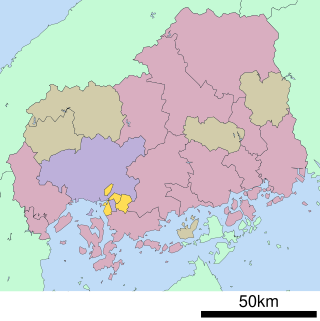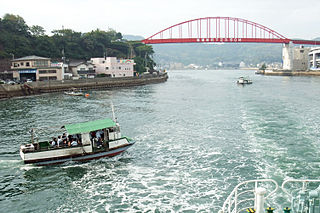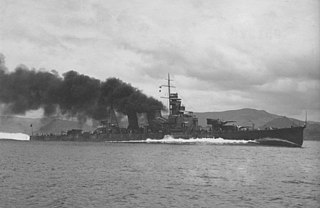 | |
| Established | 1980 |
|---|---|
| Location | Kure, Hiroshima, Japan |
| Website | www |
The Japan Coast Guard Museum is a museum dedicated to the Japanese Coast Guard in Kure, Hiroshima Prefecture, Japan. It is located on the grounds of the Japan Coast Guard Academy.
 | |
| Established | 1980 |
|---|---|
| Location | Kure, Hiroshima, Japan |
| Website | www |
The Japan Coast Guard Museum is a museum dedicated to the Japanese Coast Guard in Kure, Hiroshima Prefecture, Japan. It is located on the grounds of the Japan Coast Guard Academy.

Hiroshima Prefecture is a prefecture of Japan located in the Chūgoku region of Honshu. Hiroshima Prefecture has a population of 2,811,410 and has a geographic area of 8,479 km². Hiroshima Prefecture borders Okayama Prefecture to the east, Tottori Prefecture to the northeast, Shimane Prefecture to the north, and Yamaguchi Prefecture to the southwest.

Kure is a city in Hiroshima Prefecture, Japan. As of 30 April 2023, the city had an estimated population of 208,024 in 106,616 households and a population density of 590 persons per km2. The total area of the city is 352.80 square kilometres (136.22 sq mi). With a strong industrial and naval heritage, Kure hosts the second-oldest naval dockyard in Japan and remains an important base for the Japan Maritime Self-Defence Force.

Aki is a district, and is within the Minami-ku, Hiroshima ward, Ward, one of the eight wards that comprise the Hiroshima Prefecture, in Japan. 'Minami', is Japanese for 'South'. 'Ku', is loosely suggestive of a division, such as 'compartment', 'boundary', etc..
Yasuura was a town located in Toyota District, Hiroshima Prefecture, Japan.

The Japan Coast Guard Academy (JCGA) is a university-level service academy established within the Ministry of Land, Infrastructure, Transport and Tourism for the purpose of developing Coast Guard Officers and training students to offer several recurrent education. It is located in Kure, Hiroshima prefecture.

The Japan Coast Guard is the coast guard responsible for the protection of the coastline of Japan under the oversight of the Ministry of Land, Infrastructure, Transport and Tourism. It consists of about 13,700 personnel. The Japan Coast Guard was founded in 1948 as the Maritime Safety Agency and received its current English name in 2000.

Ondo-no-seto (音戸の瀬戸) is a strait in Seto Inland Sea in Kure, Hiroshima between the main island of Japan and Kurahashi Island.

Aoba (青葉) was the lead ship in the two-vessel Aoba class of heavy cruisers in the Imperial Japanese Navy. Launched in 1926 and heavily modernized in 1938-40, Aoba initially served as a patrol craft, largely along the China coast, and saw extensive service during World War II. Repeatedly heavily damaged and repaired, she was finally crippled by bombing and settled on the bottom of shallow Kure harbor in April 1945; two raids in late July reduced her to an unsalvageable hulk. During the attack on 24 July 1945, future Vice admiral Dick H. Guinn dropped the 2,000 lb (910 kg) bomb which contributed to her sinking.

Okamura Island is a small island in the Inland Sea of Japan. Administratively, it is part of the city of Imabari, Ehime Prefecture. The island is famous for mikan and butterflies. As of 2006, the population was about 1,000. The area is 3.13 km2 and the circumference is 11.1 km. Access is from Imabari by fast or slow ferry boat, or by road from Kure.

Kaigan-dori is a Hiroden station on Hiroden Ujina Line, located in Minami-ku, Hiroshima.

JDS Wakaba (DE-261) was the former Imperial Japanese Navy ship Nashi, an escort destroyer of the Tachibana sub-class of the Matsu class built for the Imperial Japanese Navy during the final stages of World War II. Nashi was sunk in July 1945, but salvaged in 1954 and refitted to join the Japan Maritime Self-Defense Force in 1956 as Wakaba, later being utilised as a radar trials ship, but stricken in 1971 and scrapped in 1972-1973.

Umizaru (海猿) is a 2004 Japanese action drama film directed by Eiichiro Hasumi. It is the first feature-length film of the Umizaru projects, preceding the 2005 11-episode Fuji Television and Kyodo Television drama series Umizaru Evolution and followed by the 2006 film Limit of Love: Umizaru. The film is the first of the three-part film and television project. The project is adapted from the popular 12 Shogakukan manga books Umizaru written by Yōichi Komori (小森陽一) and illustrated by Shūhō Satō from 1998 to 2001. The film stars Hideaki Itō as Japan Coast Guard (JCG) rescue diver Senzaki Daisuke, and Kato Ai as his love interest Izawa Kanna.

Kure Naval Arsenal was one of four principal naval shipyards owned and operated by the Imperial Japanese Navy.
Hiroshima Bunka Gakuen University is a private university in Kure, Hiroshima, Japan. The school first opened as a junior women's college in 1986 and became a four-year college in 1995.

Etajima base in Etajima city, Hiroshima prefecture is in the Etajima-cho government building and is the base of the Japan Maritime Self-Defense Force. Beside housing the 1st Technical School and the Officer Candidates School, it is home to the local Kure Naval District, LCAC training facilities, and Self-Defense Force oil storage. In addition, the Special Forces of the Maritime Self Defense Force is here.

The Japan Coast Guard Museum Yokohama is a museum in Naka-ku, Yokohama, Kanagawa Prefecture, Japan, dedicated to maritime security and the Japan Coast Guard. It opened on 10 December 2004.

I-56, later I-156, was an Imperial Japanese Navy Kaidai-class cruiser submarine of the KD3B sub-class commissioned in 1929. During World War II, she supported Japanese forces during the invasion of Malaya in December 1941, the Dutch East Indies campaign in early 1942, and the Battle of Midway in June 1942. Except for brief service in the Aleutian Islands campaign in 1943, she subsequently served on training duties until selected for use as a kaiten manned suicide torpedo carrier in 1945. She surrendered to the Allies in 1945 after the end of the war and was scuttled in 1946.

Akishio (SS-579) is a retired Japanese diesel-electric Yūshio-class submarine. She was laid down in 1983, launched in 1985, commissioned in 1986, and served until 2004. She served as part of both the 1st and 5th Submarine Squadrons of the 1st Submarine Flotilla. She took part in numerous drills, including the Pacific Reach 2000 drills. She is now on display outside JMSDF Kure Museum.
Küre Mountains is a mountain range in the Black Sea Region, Turkey. It stretches close and parallel to the central part of the southern coast of the Black Sea.

Ro-64, originally named Submarine No. 79, was an Imperial Japanese Navy Type L submarine of the L4 subclass. First commissioned in 1925, she served in the waters of Japan and Chōsen prior to World War II. During World War II, she operated in the Central Pacific, supported the Japanese invasion of Rabaul, and took part in the Aleutian Islands campaign, then in late 1942 was relegated to a role as a training ship. She was sunk in April 1945.